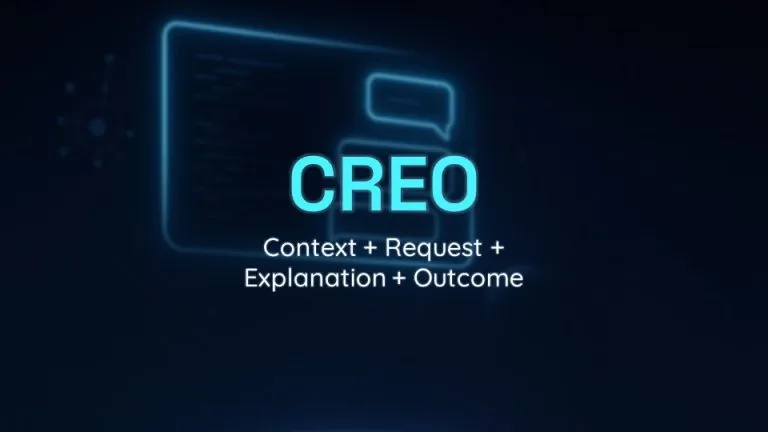CREO Framework: Context, Request, Explanation, Outcome

Imagine asking something from an artificial intelligence and receiving a response that not only meets your needs but also reflects the scenario behind your request.
The CREO framework does exactly that: it organizes your prompts to ensure the AI understands the context, carries out the task clearly, and delivers the outcome you expect.
With four components — Context, Request, Explanation, and Outcome — this structure is ideal for those who need well-grounded responses from LLMs like ChatGPT, Claude, or Gemini.
Whether you’re a professional seeking practical solutions, a student needing explanations, or someone who wants results aligned with a specific situation, CREO is a simple and effective choice. Shall we explore how it can streamline your AI interactions?
What is the CREO Framework?
The CREO framework is a straightforward structure that combines context with action, helping the AI deliver useful and relevant responses. Its four elements work together to create prompts that eliminate assumptions and focus on what really matters. Here’s each part:
Structure Components
- Context: Defines the background or situation behind the request, such as “I’m starting a business” or “my team is feeling unmotivated.”
- Request: Specifies what you want the AI to do, like “suggest ideas” or “create a plan.”
- Explanation: Details the task, explaining the goal or requirements, like “I need something simple” or “based on recent data.”
- Outcome: Describes the expected type of response, like “a step-by-step list” or “an analysis with examples.”
These components form a clear and objective prompt, perfect for tasks that need a well-defined starting point.
When to Use It?
CREO is ideal when context is essential for the outcome. Use it if:
- You want responses that consider a specific situation.
- You need explanations or plans with a clear goal.
- You’re looking for something practical and direct, yet in-depth.
- You want to avoid vague or impractical outputs.
💡 Use CREO when you want the AI to dive into your scenario and deliver something useful from the first command.
Typical example: “Considering [Context], create/develop [Request], using [Explanation]. I expect as a result [Outcome].”
Practical Examples of CREO in Action
To understand how CREO works in practice, here are three examples showing its application in real-life situations. Each highlights how the structure organizes requests clearly and effectively.
Example 1: Ideas to Boost Online Sales
Context: You have an online crafts store that has seen a drop in sales in recent months.
Considering that my online crafts store has seen a drop in sales in recent months (Context), suggest ideas to increase revenue (Request). These ideas should be practical and low-cost, since my budget is limited (Explanation), expecting a list of 4 strategies with brief descriptions (Outcome).Why it works: Context frames the problem, Request defines the task, Explanation refines the requirements, and Outcome specifies the deliverable.
Example 2: Explanation About Renewable Energy
Context: You are preparing a presentation for colleagues who don’t understand sustainability.
Given that I’ll present the topic of renewable energy to colleagues with no technical background (Context), explain what renewable energy is (Request). Use simple language and everyday examples to make it easier to understand (Explanation), expecting a short and clear paragraph (Outcome).Why it works: Context sets the scene, Request is direct, Explanation adjusts the tone, and Outcome defines the format.
Example 3: Workout Plan for Beginners
Context: You want to start exercising but have never been to a gym.
Knowing that I’m a beginner in physical exercises and have never been to a gym (Context), create a basic workout plan (Request). The plan should be safe and doable at home with simple movements (Explanation), expecting a list of 3 exercises with short instructions (Outcome).Why it works: Context informs the experience, Request sets the task, Explanation details the conditions, and Outcome organizes the output.
Tips to Make the Most of CREO
CREO is simple, but some tweaks can make it even more useful. Adjusting each element to your goal ensures the AI delivers exactly what you need. Here’s how:
Customize for Your Goal
Shape the CREO components to reflect your situation and expectations:
- Context: Be specific about the scenario. “I have a small team” is different from “I work at a growing startup.” Details guide the AI.
- Request: Refine the task for clarity. “Give ideas” is vague; “suggest 3 specific actions” is precise.
- Explanation: Add the “why” or constraints. “I want something quick” or “based on current trends” help focus the response.
- Outcome: Choose the format with intention. Lists are practical, paragraphs explain, tables compare — think about the final use.
Quick example: “Considering that I’m a high school teacher looking for new ways to engage students in history classes (Context), suggest dynamic activities to explore the topic of the Industrial Revolution (Request), using active methodologies and focusing on student participation (Explanation). I expect a list of 3 creative activities with brief application instructions (Outcome).”
These adjustments make CREO a versatile tool, ready for quick or more elaborate tasks.
Start Using CREO Today
With the CREO – Context, Request, Explanation, Outcome framework, you have a practical structure to create prompts that combine context and clarity, resulting in useful and well-targeted responses. Whether for solving problems, explaining concepts, or planning actions, it helps the AI understand your situation and deliver what you need efficiently.
🎯 Quick summary:
CREO defines the scenario (Context), tells what to do (Request), explains how to do it (Explanation), and delivers the expected result (Outcome).
🔗 Want to explore more frameworks like this?
Check out the Practical Guide to Prompt Techniques, Frameworks, and Formulas for LLMs, with dozens of detailed and applicable structures for different contexts and goals, plus techniques and prompt engineering tips.
📘 Bonus tip:
Download the free eBook “Prompt Engineering Unveiled”, featuring easy explanations, practical examples, and strategies ranging from basic to advanced to master communication with AI.



